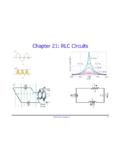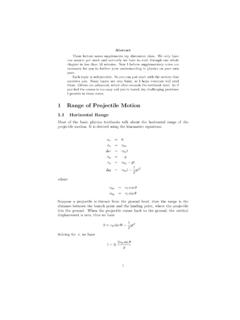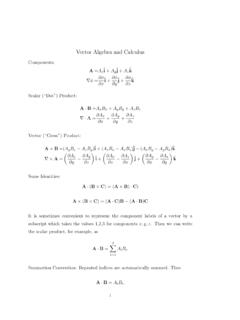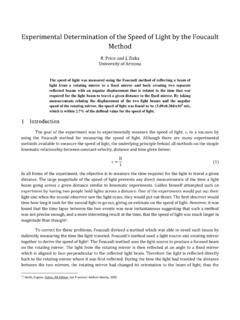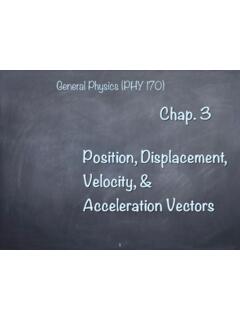Transcription of Physics Intro & Kinematics - Department of Physics
1 1 Physics Intro & Kinematics Quantities Units Vectors Displacement Velocity Acceleration Kinematics Graphing Motion in 1-DSome Physics QuantitiesVector - quantity with both magnitude (size) and directionScalar - quantity with magnitude onlyVectors: Displacement Velocity Acceleration Momentum ForceScalars: Distance speed Time Mass EnergyMass vs. WeightOn the moon, your mass would be the same, but the magnitude of your weight would be Scalar (no direction) Measures the amount of matter in an objectWeight Vector (points toward center of Earth) Force of gravity on an objectVectors The length of the arrow represents the magnitude (how far, how fast, how strong, etc, depending on the type of vector). The arrow points in the directions of the force, motion, displacement, etc.
2 It is often specified by an are represented with arrows42 5 m/sUnitsQuantity .. Unit (symbol) Displacement & Distance .. meter (m) Time .. second (s) Velocity & speed .. (m/s) Acceleration .. (m/s2) Mass .. kilogram (kg) Momentum .. (kg m/s) Force ..Newton (N) Energy .. Joule (J)Units are not the same as quantities!SI Prefixespicop10-12nanon10-9micro 10-6millim10-3centic10-2kilok103megaM106 gigaG109teraT1012 Little GuysBig Guys2 Kinematics definitions Kinematics branch of Physics ; study of motion Position (x) where you are located Distance (d) how far you have traveled, regardless of direction Displacement (Dx) where you are in relation to where you startedDistance vs. Displacement You drive the path, and your odometer goes up by 8 miles (your distance).
3 Your displacement is the shorter directeddistance from start to stop (green arrow). What if you drove in a circle?startstopSpeed, Velocity, & Acceleration speed (v) how fast you go Velocity (v) how fast and which way; the rate at which position changes Average speed ( v) distance / time Acceleration (a) how fast you speed up, slow down, or change direction; the rate at which velocity changesSpeed vs. Velocity speed is a scalar (how fast something is moving regardless of its direction). Ex: v= 20 mph speed is the magnitude of velocity. Velocity is a combination of speed and direction. Ex: v= 20 mph at 15 south of west The symbol for speed is v. The symbol for velocity is type written in bold: vor hand written with an arrow: vSpeed vs.
4 Velocity During your 8 mi. trip, which took 15 min., your speedometer displays your instantaneous speed , which varies throughout the trip. Your average speed is 32 mi/hr. Your average velocity is 32 mi/hr in a SE direction. At any point in time, your velocity vector points tangent to your path. The faster you go, the longer your velocity how fast you speed up, slow down, or change direction; it s the rate at which velocity changes. Two examples:613592571550v(mph)t(s)253282311 340v(m/s)t(s)a= +2 mph/sa= -3m/ ss= -3 m / s23 Velocity & Acceleration Sign Chart-+Moving backward;Speeding upMoving forward;Slowing down-Moving backward;Slowing downMoving forward;Speeding up+ACCELERATIONV E L O C I T YAcceleration due to m/s2 Near the surface of the Earth, all objects accelerate at the same rate (ignoring air resistance).
5 A= -g= m/s2 Interpretation: Velocity decreases by m/s each second, meaning velocity is becoming less positive or more negative. Less positive means slowing down while going up. More negative means speeding up while going acceleration vector is the same on the way up, at the top, and on the way down! Kinematics Formula Summary(derivations to follow) vf= v0+ at va vg= (v0+ vf) / 2 Dx= v0t+ at2 vf2 v02= 2aDx21 For 1-D motion with constantacceleration: Kinematics Derivationsa= Dv/Dt(by definition) a= (vf v0) /t vf= v0+ atvav g= (v0+ vf)/ 2 will be proven when we do v t= (v0+ vf)t= (v0+ v0+at)t Dx = v0 t + at221(cont.) Kinematics Derivations (cont.)21vf= v0+at t= (vf v0)/aDx= v0t+at2 Dx = v0 [(vf v0)/a]+ a[(vf v0)/a]2 vf2 v02 = 2aDx21 Note that the top equation is solved for tand that expression for tis substituted twice (in red) into the Dxequation.
6 You should work out the algebra to prove the final result on the last re riding a unicorn at 25 m/s and come to a uniform stop at a red light 20 m away. What s your acceleration? brick is dropped from 100 m up. Find its impact velocity and air arrow is shot straight up from a pit 12 m below ground at 38 its max height above what times is it at ground level? 4 Multi-step Problems1. How fast should you throw a kumquat straight down from 40 m up so that its impact speed would be the same as a mango s dropped from 60 m?2. A dune buggy accelerates uniformly at m/s2from rest to 22 m/s. Then the brakes are applied and it stops s later. Find the total distance traveled. mAnswer:Answer:Graphing !xtABCA .. Starts at home (origin) and goes forward slowlyB.
7 Not moving (position remains constant as time progresses)C .. Turns around and goes in the other direction quickly, passing up home1 D MotionGraphing w/ AccelerationxA .. Start from rest south of home; increase speed graduallyB .. Pass home; gradually slow to a stop (still moving north)C .. Turn around; gradually speed back up again heading southD .. Continue heading south; gradually slow to a stop near the starting pointtABCDT angent LinestZeroZeroPositivePositiveNegativeNe gativeVELOCITYSLOPEZeroFlatFastSteepSlow GentleSPEEDSLOPExOn a position vs. time graph:Increasing & DecreasingtxIncreasingDecreasingOn a position vs. time graph:Increasingmeans moving forward (positive direction).Decreasingmeans moving backwards (negative direction).
8 ConcavitytxOn a position vs. time graph:Concave upmeans positive downmeans negative PointstxPQRT imes when you are at home P, STime Axis InterceptTurning pointQPeak or ValleyChange of concavityP, RInflection Summarytx Concave Up Concave Down Increasing v > 0 a > 0 (A) v > 0 a < 0 (B) Decreasing v < 0 a > 0 (D) v < 0 a < 0 (C) ABCDAll 3 GraphstxvtatGraphing Animation LinkThis website will allow you to set the initial velocity and acceleration of a car. As the car moves, all three graphs are AnimationGraphing Tips Line up the graphs vertically. Draw vertical dashed lines at special points except intercepts. Map the slopes of the position graph onto the velocity graph. A red peak or valley means a blue time intercept.
9 TxvtGraphing TipsThe same rules apply in making an acceleration graph from a velocity graph. Just graph the slopes! Note: a positive constant slope in blue means a positive constant green segment. The steeper the blue slope, the farther the green segment is from the time lifeNote how the vgraph is pointy and the agraph skips. In real life, the blue points would be smooth curves and the green segments would be connected. In our class, however, we ll mainly deal with constant under a velocity graphvt forward area backward area Area above the time axis = forward (positive) below the time axis = backward (negative) area (above - below) = net area (above + below) = total distance areas above and below are about equal, so even though a significant distance may have been covered, the displacement is about zero, meaning the stopping point was near the starting point.
10 The position graph shows this forward area backward area txArea units Imagine approximating the area under the curve with very thin rectangles. Each has area of height width. The height is in m/s; width is in seconds. Therefore, area is in meters!v(m/s)t(s)12 s12 The rectangles under the time axis have negative heights, corresponding to negative of a ball thrown straight up xvaThe ball is thrown from the ground, and it lands on a position graph is ball peaks at the parabola s vgraph has a slope of out the slopes!There is more positive area than negative on the PracticeTry making all three graphs for the following scenario:1. Schmedrick starts out north of home. At time zero he s driving a cement mixer south very fast at a constant He accidentally runs over an innocent moose crossing the road, so he slows to a stop to check on the poor He pauses for a while until he determines the moose is squashed flat and deader than a Fleeing the scene of the crime, Schmedrick takes off again in the same direction, speeding up When his conscience gets the better of him, he slows, turns around, and returns to the crash PracticeA catcher catches a 90 mph fast ball.
